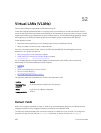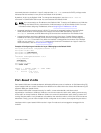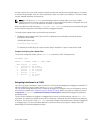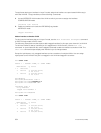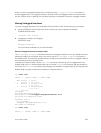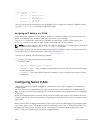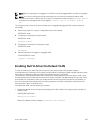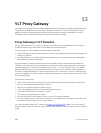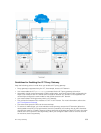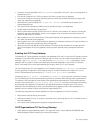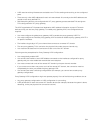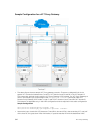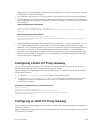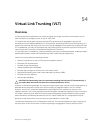
53
VLT Proxy Gateway
The Virtual link trucking (VLT) proxy gateway feature allows a VLT domain to locally terminate and route
L3 packets that are destined to a Layer 3 (L3) end point in another VLT domain. Enable the VLT proxy
gateway using the link layer discover protocol (LLDP) method or the static configuration. For more
information, refer to Dell Networking OS Command Line Reference Guide.
Proxy Gateway in VLT Domains
Using a proxy gateway, the VLT peers in a domain can route the L3 packets destined for VLT peers in
another domain as long as they have L3 reachability for the IP destinations.
A proxy gateway in a VLT domain provides the following benefits:
• Avoids sub-optimal routing of packets by a VLT domain when packets are destined to the endpoint in
another VLT domain.
• Provides resiliency if a VLT peer goes down by performing proxy routing for the peer’s destination
MAC address in another VLT domain.
A typical scenario is virtual movement of servers across data centers. Virtual movement enables live
migration of running virtual machines (VMs) from one host to another without downtime. For example,
consider a square VLT connecting two data centers. If a VM, VM1 on Server Rack 1 has C as its default
gateway and VM1 performs a virtual movement to Server Rack 2 with no change in default gateway. In
this case, L3 packets destined for C can be routed either by C1 or D1 locally. To do this, install the local
system mac address of C and D in both C1 and D1 so the packets for C and D could have a hit at C1 /D1
and be routed locally.
The following figure shows:
• Server racks, named Rack 1 and Rack 2, are part of data centers named DC1 and DC2, respectively.
• Rack 1 is connected to devices A and B in Layer 2.
• Rack 2 is connected to devices A and B in Layer 2.
• A VLT link aggregation group (LAG) is present between A and B.
• A and B are connected to core routers, C and D.
• VLT routing is present between C and D.
• C1 and D1 are Layer 3 core routers in DC2, in which VLT routing is enabled.
• The core routers C and D in the local VLT domain is connected to the core routers C1 and D1 in the
remote VLT Domain using VLT links in eVLT fashion.
For more information about eVLT, refer to the Virtual Link Trunking (VLT) chapter. The core or Layer 3
routers C and D in local VLT Domain and C1 and D1 in the remote VLT Domain are then part of a Layer 3
cloud.
938
VLT Proxy Gateway



